Related Research Articles

Lake Tanganyika is an African Great Lake. It is the second-oldest freshwater lake in the world, the second-largest by volume, and the second-deepest, in all cases after Lake Baikal in Siberia. It is the world's longest freshwater lake. The lake is shared between four countries – Tanzania, the Democratic Republic of the Congo (DRC), Burundi, and Zambia, with Tanzania (46%) and DRC (40%) possessing the majority of the lake. It drains into the Congo River system and ultimately into the Atlantic Ocean.

Ahaetulla, commonly referred to as Asian vine snakes or Asian whip snakes, is a genus of colubrid snakes distributed throughout tropical Asia. They are considered by some scientists to be mildly venomous and are what is commonly termed as 'rear-fanged' or more appropriately, opisthoglyphous, meaning their enlarged teeth or fangs, intended to aid in venom delivery, are located in the back of the upper jaw, instead of in the front as they are in vipers or cobras. As colubrids, Ahaetulla do not possess a true venom gland or a sophisticated venom delivery system. The Duvernoy's gland of this genus, homologous to the venom gland of true venomous snakes, produces a secretion which, though not well studied, is considered not to be medically significant to humans.

Perameles is a genus of marsupials of the order Peramelemorphia.
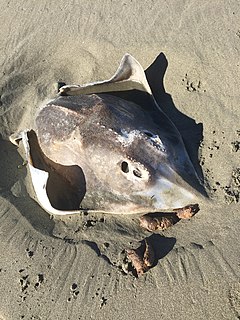
The New Zealand rough skate, Zearaja nasuta, is a skate of the genus Zearaja, found around New Zealand at depths between 10 and 1,500 m. Its length is up to 1 m. This species has been assessed by the IUCN as of Least Concern. In June 2018 the New Zealand Department of Conservation classified the New Zealand rough skate as "Not Threatened" with the qualifier "Conservation Dependant" under the New Zealand Threat Classification System.

The long-nosed horned frog, also known as the Malayan horned frog or Malayan leaf frog is a species of frog restricted to the rainforest areas of southern Thailand and Peninsular Malaysia to Singapore, Sumatra and Borneo. However, records from Thailand to the Sunda Shelf may apply to another, possibly unnamed species.
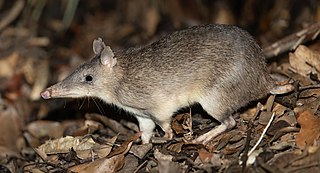
The long-nosed bandicoot is a species of bandicoot found in eastern Australia, from north Queensland along the east coast to Victoria. Around 40 centimetres (16 in) long, it is sandy- or grey-brown with a long snouty nose. Omnivorous, it forages for invertebrates, fungi and plants at night.
Agathiphaga is a genus of moths in the family Agathiphagidae, known as kauri moths. This caddisfly-like lineage of primitive moths was first reported by Lionel Jack Dumbleton in 1952, as a new genus of Micropterigidae.
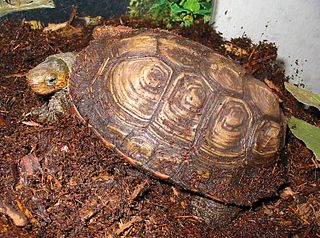
Rhinoclemmys is a genus of turtles in the family Geoemydidae, the only genus in the subfamily Rhinoclemmydinae. Member species of the genus are commonly known as the Neotropical wood turtles and are the only geoemydids known from the Americas. As such, they have adapted to a wide range of habitats, which is reflected in the species' common names.

The large-nosed wood turtle is one of nine species of turtle in the genus Rhinoclemmys of the family Geoemydidae. It is found in Colombia and Ecuador.
Psammphiletria is a genus of loach catfishes found in the Congo River Basin.

Dyakiidae is a family of air-breathing land snails terrestrial pulmonate gastropod mollusks in the superfamily Dyakioidea.
Rhynchobombyx is a monospecific moth genus in the family Lasiocampidae first described by Per Olof Christopher Aurivillius in 1908. It contains the single species Rhynchobombyx nasuta, described by the same author in the same year.
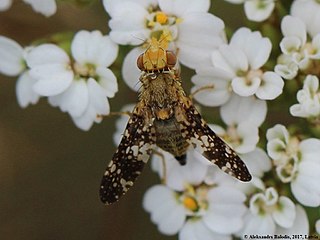
Oxyna is a genus of fruit flies in the family Tephritidae. There are at least 20 described species in Oxyna.

Rhinocochlis nasuta is a species of air-breathing land snails, terrestrial pulmonate gastropod mollusks in the family Dyakiidae.

Gobiodon histrio, the Broad-barred goby, is a species of goby native to the Indian Ocean from the Red Sea to the western Pacific Ocean to southern Japan, Samoa and the Great Barrier Reef. This species is a reef dweller, being found at depths of from 2 to 15 metres. It can reach a length of 3.5 centimetres (1.4 in) TL. This species can also be found in the aquarium trade.
Njalila is an informal name for a genus of gorgonopsian therapsids from the Late Permian of southern Africa. Fossils have been found from Malawi, Zambia, and Tanzania.
Alucita nasuta is a moth in the family Alucitidae. It is found from Colombia north to Mexico.

Agerostrea is an extinct genus of fossil oysters, marine bivalve molluscs in the family Ostreidae, the true oysters. The genus Agerostrea is present in the Maastrichtian, the upper stage of the Late Cretaceous epoch, from 72.1 to 66 million years ago.
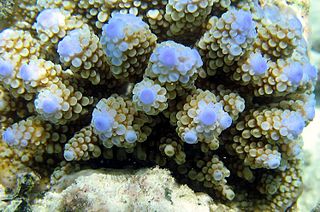
Acropora nasuta is a species of branching stony coral in the family Acroporidae. It is native to the western and central Indo-Pacific where it is found in shallow reef habitats. Like other corals of the genus Acropora, it is susceptible to coral bleaching and coral diseases and the IUCN has listed it as being "Near Threatened".

Erythranthe, the monkey-flowers and musk-flowers, is a diverse plant genus with at least 111 members in the family Phrymaceae. Erythranthe was originally described as a separate genus, then generally regarded as a section within the genus Mimulus, and recently returned to generic rank. Mimulus sect. Diplacus was segregated from Mimulus as a separate genus at the same time. Mimulus remains as a small genus of eastern North America and the Southern Hemisphere. Molecular data show Erythranthe and Diplacus to be distinct evolutionary lines that are distinct from Mimulus as strictly defined.
References
- ↑ Nuss, M.; et al. (2003–2011). "GlobIZ search". Global Information System on Pyraloidea. Retrieved September 29, 2011.
- ↑ Beccaloni, G.; Scoble, M.; Kitching, I.; Simonsen, T.; Robinson, G.; Pitkin, B.; Hine, A.; Lyal, C., eds. (2003). "Ethiopsella nasuta". The Global Lepidoptera Names Index . Natural History Museum . Retrieved May 3, 2018.
| This Phycitinae-related article is a stub. You can help Wikipedia by expanding it. |